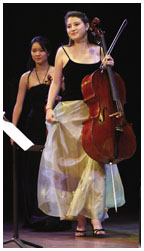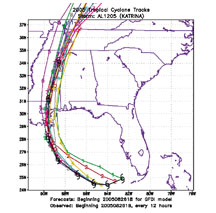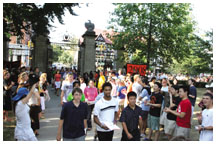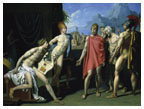
|
|
October 5, 2005: Notebook
Coping with Katrina
For hurricane victims, an outpouring of support from the Princeton community
Celebrating a new year, but with a serious note
Carolyn Wu ’08, left, and Caroline-Ami Connolly ’07 take a bow after their performance during a concert to benefit victims of Hurricane Katrina. (Frank Wojciechowski) |
Coping
with Katrina
For hurricane victims, an outpouring of support from the Princeton
community
Growing up in New Orleans, Renea Henry ’92 learned her family’s routine for hurricanes. She and her parents would pick up her grandmother, who lived in one of the city’s low-lying areas, and take her to their house, on higher ground, to wait out the storm. The next day, her grandmother would return home.
But when Henry heard the calls for evacuation as Hurricane Katrina approached on Aug. 27, she feared that this storm would be different from others the family had seen. In the early morning of Aug. 28, she took her grandmother northwest to Port Allen, La., across the Mississippi River from Baton Rouge. Her parents followed a few hours later.
“I didn’t think it would be any more than a few days,” said Henry, who packed a weekend bag and her laptop computer. Two weeks later, she and the hundreds of thousands of other displaced residents from New Orleans were still waiting to go home, wondering and worrying about the long road to recovery that lay ahead.
According to the Alumni Council, approximately 425 Princeton alumni live in the region affected by Hurricane Katrina, and the storm’s widespread destruction inspired an outpouring of support from the Princeton community. An alumni e-mail discussion group was up and running four days after the hurricane struck land, helping people to coordinate relief efforts already in the works.
The University opened its doors to displaced students, welcoming 25 undergraduates and five graduate students on campus for the fall semester, tuition free. Enrolled students whose families were affected by the hurricane are eligible for additional financial aid. Up to 10 visiting appointments were made available for displaced scholars. In addition, the University announced that it will partner with Brown University to help rebuild Dillard University, a historically black university with nearly 2,000 students in New Orleans, pledging resources for physical planning and administrative services.
Princeton students performed at two benefit concerts during the first week of classes. A significant number of students hope to volunteer in the rebuilding effort during fall break, said Kiki Jamieson, director of the Pace Center, which encourages public service.
Peter Lafen ’73 of Silver Spring, Md., took the lead on the “Hurricane Katrina Recovery” e-mail list on TigerNet, tapping the alumni community’s interests in service and charity. More than 200 subscribers joined in the first week. Posted messages included offers of temporary housing, efforts to check in with displaced alumni, and calls for specific donations. Through classmates Marta Richards ’73 of Baton Rouge and George DeMontrond ’73 of Houston, Lafen made contacts to help distribute 5,000 backpacks, which were filled with school supplies and donated by residents in Montgomery County, Md., to children at hurricane relief centers.
Richards said the atmosphere in Baton Rouge was hectic but helpful, with people “just trying to make things work.” Traffic left streets gridlocked, and helicopters carrying critical supplies touched down in school playgrounds. The Louisiana State University basketball arena became a hospital for evacuees. The veterinary school housed rescued pets.
Mindy Patron ’91, the president of the Princeton Alumni Association of New Orleans, was among the evacuees in Baton Rouge. She came with her husband, David Patron ’90, and their 2-year-old twins. While she was thankful to have housing and a temporary office, provided by her law firm’s local office, Patron was also determined to return to the house they evacuated. “We’re definitely moving back to New Orleans,” she said. “That’s our home.”
For Jennifer (Bello) Langin ’98 and her family, the move from New Orleans may be permanent. With her husband, William ’99, and 5-month-old son, Tyler, Langin left the city early and stayed with her mother in Boca Raton, Fla. After the storm, William, a scientist for Shell Oil, learned that a scheduled transfer to Houston might be coming sooner than expected. Their house, near the river in Algiers, La., sustained minimal damage. “We feel like we’re the best-case scenario,” Jennifer Langin said. “We feel very lucky.”
Steve Richer ’68 of Gulfport, Miss., evacuated safely, but his home bore the marks of the powerful storm. When he returned, three 100-foot-tall pine trees rested on the house and a foot of water had collected inside. His key worked, but the swollen front door would not budge until he rammed it with a log cut from one of the fallen pines. Beyond his personal rebuilding, Richer, the executive director of the Mississippi Gulf Coast Convention Visitors Bureau, is working to replace the 20,000 jobs in tourism and hospitality that were wiped out by the hurricane.
Near Gulfport, radio reporter Dan Grech ’99 covered the hurricane’s aftermath in Mississippi and Alabama for American Public Media’s “Marketplace” (his reports are online at marketplace.publicradio.org/features/Katrina/grech.php). “I know what hurricanes look like,” said Grech, who lives in Miami, “and this was ridiculous. Entire cities were washed out to sea.” But in the wake of extraordinary tragedy, Grech said, he saw “the best of human nature” as neighbors helped one another cope.
Back in her Port Allen hotel room, Renea Henry contemplated her future
and the likelihood of relocating, using her network of Princeton contacts
to search for job opportunities in Washington, D.C. She also fielded calls
and e-mails from friends, who asked what they could do to help. “I
encourage people to offer their support, but I encourage them to offer
their support with an eye for the long term,” she said. “After
the 24-hour-a-day news coverage goes away, people are still going to be
putting their lives back together.” ![]()
By B.T.

Tim Marchok,
left, and Morris Bender of the Geophysical Fluid Dynamics Laboratory
work on a hurricane computer model.
|
In a nondescript building east of Route 1 not far from Princeton’s main campus, days before Hurricane Katrina touched land, research meteorologists Morris Bender and Tim Marchok followed the storm’s path from the gulf coast of Florida to the city of New Orleans and up the east side of the Mississippi River. The track was generated by a computer model that, in one hour of processing, turns atmospheric data into a five-day hurricane forecast. And in the case of Katrina, it was remarkably accurate.
“Our model predicted Katrina, from Friday morning on, to be a category 4, affecting the area near New Orleans,” Bender said.
Bender and Marchok work in the hurricane dynamics program at the Geophysical Fluid Dynamics Laboratory (GFDL) at Princeton’s Forrestal campus, a National Oceanic and Atmospheric Administration facility that has collaborative links with the University’s program in atmospheric and oceanic sciences.
The GFDL model, one of five used by the National Hurricane Center, started as a research tool but was upgraded for predictive purposes in the late 1980s and early 1990s. Since then, the lab has coupled its atmospheric model with the Princeton Ocean Model, a complex tool initially developed by George Mellor, professor of mechanics, mechanical and aerospace dynamics, emeritus. With the ocean model in place, Marchok said, the GFDL model can more accurately forecast a hurricane’s intensity.
Because it is devoted specifically to hurricanes, the GFDL model provides detail and complexity that global weather models cannot match. “It’s the only model that can correctly represent the interaction of the storm with its environment,” Bender said.
While no single model can predict the path of every hurricane, use of
the five models has enabled the National Hurricane Center to greatly improve
its capabilities, cutting its margin of error in half during the last
15 years. “They basically take a consensus,” Bender said,
“and that ends up beating every model.” ![]()
By B.T.

Members of the Class of 2009 are welcomed by upperclassmen during the second annual Pre-rade. (Denise Applewhite) |
Celebrating a new year, but with a serious note
Jam-packed cars parked on manicured lawns. Welcome-back barbecues in gothic courtyards. Starry-eyed freshmen wandering around with tired parents in tow. These are the signs of Freshman Week at Princeton.
From Sept. 9 through the first day of classes on the 15th, incoming freshmen took time to move into their dorm rooms and get their bearings. For returning students, it was an opportunity to catch up with old friends and put off anxiety about the challenging academics ahead. This year’s Freshman Week was filled with activities from shopping at Target to applauding the spirited student performances at Tiger Night.
“Orientation is a little overwhelming,” said Nikhil Gupta ’09 about the numerous freshmen events. As he prepared to visit the music department’s open house, Nikhil sheepishly admitted, “I feel like I’m one step behind everyone else.” His older sister, Nandita Gupta ’06, counseled, “Everyone feels like that. I know I did.”
Some students were returning from their Community Action service projects, like painting an office and sorting food for a nonprofit group in nearby Hightstown. Others partied at the Outdoor Action dance after returning from their OA adventures — celebrating, among other things, fresh clothes and showers. The next night, freshmen were welcomed into their residential colleges with barbecues and meetings with residential advisers.
At the second annual Pre-rade, freshmen marched through the FitzRandolph Gate and received a warm reception in front of Nassau Hall: Cheerleaders performed, the University Band played, and hundreds of upperclassmen waved and clapped as the new Princetonians walked by.
In all, the week offered a mix of more serious activities and a sense of Princeton’s social scene on the Street. “There’s definitely a sense of work hard, play hard already,” said Kristen Badal ’09. “The freedom is incredible.”
President Tilghman offered a personal greeting to the Class of 2009 at Opening Exercises in the University Chapel. While noting that the start of the academic year is “traditionally a festive occasion,” she took a more somber tone because of its timing: the fourth anniversary of the Sept. 11 terrorist attacks, and less than two weeks after the Gulf Coast was struck by Hurricane Katrina.
“This hurricane is a huge problem — there is a lot to do,” said Leslie Bernard Joseph ’06, Undergraduate Student Government president. With benefit concerts lined up and a volunteering trip to the Gulf Coast in the works, the USG and other student groups were hard at work to help the victims of Katrina. Students also reached out to visiting undergraduates from Gulf Coast colleges, helping them pick their classes.
While the orientation activities and Katrina relief efforts were connected by timing, they shared a more concrete link: Freshman Week is partly about encouraging students to step out of their comfort zones and embrace a sense of civic duty.
At the Freshmen Assembly lecture, philosophy professor K. Anthony Appiah
urged the Class of 2009 to take a “cosmopolitan view” toward
other citizens of the world. “You may or may not like strangers,
or their ways,” Appiah said, “but the very essence of morality
requires that you should accept that we have a shared responsibility for
the human fate.” ![]()
By Allison Berliner ’06
By the numbers: The Class of 2009
Students: 1,229
Applicants: 16,510
Percent admitted: 10.9
Percent on financial aid: 55
Percent men: 53.4
Percent women: 46.6
States represented: 49 (plus Washington, D.C.)
State with most enrolled: New Jersey (174)
State not represented: Nebraska
Countries represented: 37
Percent students of color: 35.2
Percent international students: 8.9
Percent sons/daughters of alumni: 12
Source: Office of Admission. Figures are for the pre-registration period.

Jeremiah S. Finch, a professor emeritus of English who also served as
dean of the college and secretary of the University, died Aug. 25 in Jamesburg,
N.J. He was 95. Finch joined the faculty in 1936 and led classes in English
literature until his retirement in 1974. He also wrote several works on
the University’s history.
![]()

(Jean-Auguste-Dominique Ingres (1780-1867), Courtesy PUAM) |
Robert B. Barnett, who has helped Democratic presidential and vice presidential candidates prepare for their campaign debates for two decades, will offer an INSIDER’S VIEW OF THE DEBATES at 4:30 on Thursday, Oct. 6, in Bowl 016 of Robertson Hall. Barnett is senior partner with William & Connolly, Washington, D.C.
A two-day symposium, “DARK ROOMS: PHOTOGRAPHY AND INVISIBILITY,” will be held in McCosh 50 Oct. 7–8. The free symposium, organized by Professor Anne McCauley and sponsored by the David A. Gardner ’69 Magic Project and the Department of Art and Archaeology, focuses on how photography explored the limits of the visible and the world of the invisible through the early 20th century. Online registration is required at web.princeton.edu/sites/Artand Archaeology/DarkRooms.
“THE LEGACY OF HOMER,” an exhibition of French works of art from the 17th and 18th centuries that interpret the writings of Homer, opens Oct. 8 at the University Art Museum and runs through Jan. 15. Artists represented will include Poussin, Ingres, D’Angers, and David. The influence of Homer in French, European, and American art and literature will be discussed at a symposium at the museum Oct. 9 from 8:30 to 5 p.m. The symposium is free, but advance registration is required. Contact Andrea Stearly at 609-258-1741, or e-mail astearly@ princeton.edu. A partnership with New York’s Dahesh Museum of Art is bringing the works from the Ecole des Beaux-Arts in Paris.
JANINE DIGIOVANNI, who has reported from war zones
for more than a decade, will speak on “Other Than Collateral Damage:
The Effect of War on Women and Children (Iraq, Afghanistan, Africa)”
at 4:30 p.m. Monday, Oct. 10, in Bowl 016, Robertson Hall. DiGiovanni,
senior correspondent for the Times of London and Vanity Fair,
is the author of “Madness Invisible: A Memoir of War.”
![]()

(Steven Veach) |
Precious polish
Six thousand years ago, Chinese artisans used diamonds to grind and polish
ceremonial stone burial axes with a level of skill that rivals modern
polishing techniques, according to a study by Nan Yao, a senior research
scientist at the Princeton Institute for the Science and Technology of
Materials (PRISM); Peter Lu ’00, a physics graduate student at Harvard;
George Harlow *77 of the American Museum of Natural History; and three
other colleagues. The finding, published in the February issue of Archaeometry,
marks the earliest-known use of diamonds. The researchers used scanning
electron microscopy to test their hypothesis; the project also uncovered
early uses of sapphire, between 4000 B.C. and 2500 B.C., in the polished
axes of China’s Liangzhu and Sanxingcun cultures.
![]()

A UNIVERSITY SENIOR was hospitalized with a spinal cord injury after a water-related accident on Sept. 9, the last day of an Outdoor Action trip in Pennsylvania that he was helping to lead. The student, identified by the Daily Princetonian as Steven Anderson ’06, was reported in serious but stable condition at the Regional Spinal Cord Injury Center of the Delaware Valley in Philadelphia. “Early indications are that the student was not at fault,” said University spokeswoman Cass Cliatt ’96. She said OA has “a superb safety record.”
A new University policy provides ASSISTANT PROFESSORS with an extra year before their tenure review for every child born or adopted during their tenure pursuit, which typically takes six years. The policy change was recommended in 2003 by the Task Force on the Status of Women Faculty in the Natural Sciences and Engineering, which found that while junior faculty could request such an extension, some declined to do so because they felt it would hurt their chances for tenure. The American Council on Education said Princeton is the first American university to adopt such a policy.
The University library has acquired the papers of controversial scientist and author IMMANUEL VELIKOVSKY, who lived in Princeton for a number of years prior to his death in 1979. Velikovsky’s theories that catastrophes referred to in the Bible and other ancient accounts were caused by close approaches to Earth by Venus and Mars made him a popular author but set off decades of bitter scientific debate. “In accepting these papers, the University is not subscribing to his ideas,” said Don Skemer, curator of manuscripts in the library’s Department of Rare Books and Special Collections. He said the papers fit in with existing collections focused on the history of publishing.
The Woodrow Wilson School has launched the UNIVERSITY CHANNEL, a Web service that offers free lectures from Princeton, Harvard, Penn, and other universities online, via streaming video or as audio podcasts. The service focuses on public policy and international affairs, but may expand in the future. The site can be reached at uc.princeton.edu.
The Frist Filibuster was named “PROTEST OF THE YEAR”
in Mother Jones’ annual roundup of college campus activism.
Students, faculty, and area politicians took part in the 384-hour protest,
held in front of the University’s Frist Campus Center to protest
Senate Majority Leader Bill Frist ’74’s proposal to ban judicial
filibusters. The magazine said Princeton students had created “the
mother of all filibusters,” noting similar protests followed on
50 campuses in 35 states. ![]()


 At
right, the GFDL model’s periodic projections closely tracked
Hurricane Katrina’s actual path (in black).
At
right, the GFDL model’s periodic projections closely tracked
Hurricane Katrina’s actual path (in black). 

